Tips from the Rijksmuseum: how to reach young people from the Caribbean
When reaching out to participants in the Caribbean, Merel reveals, using their network was crucial: “Photographer Sharelly Emanuelson lives and works in Curaçao. She was on the jury and also gave the competition masterclass. She really helped us raise the competition’s profile in the education sector. In the end, an entire class from one school took part! I promoted the competition on a radio station that is popular with younger listeners.”
Tip 1: Get personal
“Personal contact is where it all begins. You need to get to know each other and tell people about your organisation or activity. This can also be done online. It’s about speaking to each other and being able to put a face to a name. From that point on, your best asset is word-of-mouth. As an institution, you also need to raise your profile in the Caribbean. Many young people there have no idea what the Rijksmuseum is, or have no real emotional connection to us. Often they assume the competition is not for them because it has been organised in the Netherlands.”
“That’s why we made a point of saying from the outset that anyone who made the shortlist could come to the Netherlands. Ultimately, we received six submissions from the Caribbean. Out of a total of ninety, that’s a decent start.”
Tip 2: Opt for a topical theme
“The theme of this year’s competition was Een tweede leven: hoe recycle jij (‘A second life: how do you recycle?’) A topic with relevance for every young person. Sorting waste, finding ways to repair or reuse things. Another interesting aspect of this topic is the exchange of ideas it encouraged between young people from the Netherlands and their counterparts in the Caribbean. Many families in the Caribbean are financially worse off than Dutch families. Under those circumstances, an issue like reuse takes on a whole different meaning.”
“The fact that everything has to be imported on the island is another significant factor. Once something is on the island, it’s there to stay. The interaction between the young entrants gave them a different perspective on sustainability. A ‘second life’ is more self-evident on the islands, compared to a consumer society like the Netherlands.”

Tip 3: Make use of intermediaries
“Intermediaries can play a major role, both people in the Netherlands with an active network in the Caribbean and people on the islands with a network in the fields of culture and/or education.”
Tip 4: Translation is vital
“Translation is another vital factor, in English and Papiamentu. There are also increasing numbers of Spanish speakers on the islands.”
Tip 5: Make sure you are well-informed
“To work with the education sector in the Caribbean part of the Kingdom, it’s handy to know how the sector operates. Aruba, Curaçao and Sint Maarten are separate countries within the Kingdom, each with their own policy on education. Bonaire, Saba and Sint Eustatius are part of the Caribbean Netherlands but they each have their own interpretation of education and arts education, to some extent.”
Tip 6: Remove barriers
“It’s important to remove barriers wherever you can. What are the best ways to communicate? Which media are most effective? Is there a special way to appeal to your target group? Key to the competition’s appeal was the opportunity it offered young people to come to the Netherlands.”
Tip 7: Last but not least: budget
“Having a network on the islands is important, but giving islanders the opportunity to come to the Netherlands is of at least equal importance. For smaller institutions in particular, the lack of budgetary resources can be a barrier, so a contribution from a fund or foundation in the Netherlands can add considerable value.”
More information about the photo competition
Kyle Siliee, from Abel Tasman College on Curaçao, is the winner of this year’s Document Nederland Junior photo competition. His series about the vegetable garden tended to by his class made a deep impression on the competition’s organisers at the Rijksmuseum. Kyle and fellow shortlisted candidate Janae (also from Curaçao) were given the opportunity to come to the Netherlands with a companion at the Rijksmuseum’s expense.
In the Netherlands, they had the chance to participate in two masterclasses given by photographer Sharelly Emanuelson and experts from the Rijksmuseum. Masterclass participants worked together to create an artwork that went on to form part of the Document exhibition. It consists of still lifes made of waste from Amsterdam’s canals, a collaboration with Plastic Halle Foundation. All of the competition entries can be viewed online. The Document Nederland Junior exhibition runs until 15 February 2023.
Reageer (je reactie verschijnt na goedkeuring, vanwege spam)